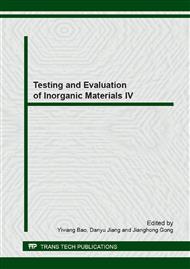p.134
p.138
p.145
p.150
p.154
p.159
p.164
p.168
p.172
The Effects of Load and Frequency on the Fatigue Damage of Bi-Layered Zirconia and Alumina Dental Composites
Abstract:
It is significant to explore the fatigue contact damage of bi-layer ceramic composites in order to improve the long-time mechanical reliability of bi-layer structured dental restorations. In this study, Hertz contact test was used to compare the fracture modes and the ability of anti-fatigue damage of zirconia and alumina bi-layer composites, to analyze the effect of loading rate and other factors on the damage mechanisms of bi-layer ceramic composites. Cyclic spherical fatigue loading was put on the bi-layer alumina and zirconia composites with different substrates. The samples were observed by high depth of field stereomicroscope and digital optical microscope after test. The results showed that the fatigue contact damage mode of zirconia bi-layer composite was the porcelain fracture from radial cracks without the damage of zirconia core. The fatigue contact damage mode of alumina bi-layer composite was the alumina core failure from radial cracks as the function of contact load. For both of zirconia and alumina bi-layer samples, the number of cycles to the sample failure as the function of same maximum contact load with high loading rate was obviously smaller than low loading rate. The mechanical properties of the substrate materials had limited effects on the number of cycles to the failure of both zirconia and alumina bi-layer samples from contact-induced radial cracks as maximum contact load with low loading rate. The ability of the zirconia bi-layer composites to resist fatigue damage was much higher than that of the alumina bi-layer composites.
Info:
Periodical:
Pages:
154-158
Citation:
Online since:
November 2013
Authors:
Keywords:
Price:
Сopyright:
© 2014 Trans Tech Publications Ltd. All Rights Reserved
Share:
Citation:


